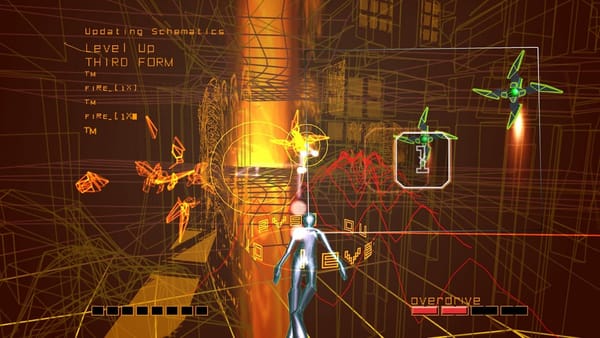I still feel a little thrill whenever I come across anything related to Rez—whether it’s promotional material, the iconic box art, or even the infamous Rez Trance Vibrator.
Its timeless cool factor comes from a perfect blend of striking aesthetics and its deep focus on music. When Rez launched on the Dreamcast and then the PlayStation 2, it initially felt less like a game and more like an audiovisual experience that redefined gaming experiences.
Hyperbole? I don't think so. I genuinely feel like experiences like this are few and far between. It was as special as the first time I played Wipeout. To this day, it continues to captivate loyal fans, a testament to its unparalleled artistic ambition and enduring cultural legacy.
A Fusion of Art and Technology
At its core, Rez is a rail shooter. But calling it that feels reductive.
Developed by Tetsuya Mizuguchi and United Game Artists, the game was an ambitious attempt to merge synesthesia—where senses overlap—with gameplay. Every action in Rez—firing shots, defeating enemies, or navigating its surreal levels—is tied to its pulsing electronic soundtrack, creating a unique feedback loop of visual, auditory, and tactile stimulation.

The game’s minimalist wireframe visuals drew inspiration from early computer graphics and digital art, giving it a timeless and otherworldly aesthetic.
Combined with its dynamic soundtrack, Rez offered an interactive music experience that feels as fresh today as it did at launch. This seamless integration of music, visuals, and gameplay broke ground, setting the stage for modern rhythm-based and interactive music games.
Cultural Impact: Gaming as Art
Rez wasn’t just another game—it was a full-on cultural statement. Though, if you’d asked creator and game designer Tetsuya Mizuguchi at the time, he’d probably have played it down.
Rez dropped at a time when games were still battling to be seen as art, boldly proving they could spark emotion, challenge perspectives, and push beyond traditional genres.
It didn’t take long for Rez to find its way into art galleries and exhibitions, celebrated as a digital masterpiece. And while it wasn’t a blockbuster success upon release, its cult status quickly grew.
It resonated with a wide range of audiences, including those outside of the traditional gaming world, sparking conversations about the artistic potential of video games.
Rez made its mark in the art world, showing up in the Smithsonian American Art Museum’s 2012 exhibit, The Art of Video Games, which celebrated 40 years of gaming as an art form.
It also featured in the Virtual Realms: Videogames Transformed exhibit at Singapore’s ArtScience Museum, where game developers and media designers teamed up to create immersive experiences that showed just how artistic games can be.

"The first realm of the exhibition looks at synesthesia — a neurological phenomenon in which the boundaries between the senses are blurred and sounds can be 'seen' and visuals can be 'heard' or 'felt'. Exhibition co-curator and lead game designer at Enhance, Tetsuya Mizuguchi has explored the potential of synesthesia since his 2001 game, Rez."
In part, Rez has helped dismantle the stigma that games were purely recreational, positioning them instead as a legitimate medium of expression.
A Design Masterclass
From a design perspective, Rez exemplifies elegance and focus. Stripping away complexity, it offers a pure and immersive experience. The absence of unnecessary clutter allows its core elements—music, visuals, and gameplay—to shine in unison.
This philosophy of "less is more" has inspired countless developers.
Titles like Journey and Tetris Effect—another Mizuguchi creation—owe much to Rez’s pioneering approach. The game’s insistence on harmonising mechanics and aesthetics has left an indelible mark on the industry, encouraging designers to prioritise emotion and immersion over traditional measures of success.

Additionally, Rez’s interactivity was groundbreaking. By making the player’s actions integral to the music and visuals, it created a sense of connection rarely seen in games.
This approach has influenced modern titles that aim to bridge the gap between gameplay and player expression.
A Lasting Legacy
Rez continues to inspire.
Its re-releases and adaptations, including the critically acclaimed Rez Infinite for VR, have introduced it to new generations, amplifying its synesthetic vision. The VR experience, in particular, enhances the immersion, fully surrounding players in its pulsating world of sound and light.
More than two decades after its debut, Rez remains a benchmark for innovation in gaming.
It challenges developers to think differently and reminds players of the medium’s capacity to evoke wonder. Its impact isn’t just measured by the games it inspired, but by the way it shifted perceptions of what games could be.
In the end, Rez is more than a game—it’s a game design revolution.
By daring to push the boundaries of technology, art, and interactivity, it achieved something rare: timeless relevance. It’s a testament to the power of bold creativity and a reminder that the best ideas are often the ones that refuse to conform.










